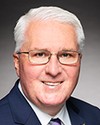moved that the bill be read the third time and passed.
Madam Speaker, I am proud to rise in the House today to speak to Bill C-18, and to the work that has been accomplished to bring forward the proposed amendments to this important legislation for the future of Parks Canada.
I want to personally thank my hon. colleagues and the Standing Committee on Environment and Sustainable Development for their careful analysis of the proposed legislation. I encourage all members to join me today in supporting Bill C-18 at third reading so that it can make its way to the Senate.
The timing of the proposed legislation is significant as we celebrate the 150th anniversary of Confederation and the centennial of national historic sites.
Canada's national parks and national historic sites enable Canadians to experience our rich history and heritage. The legislation before us would give Parks Canada the authorities it needs to build on its role as a world leader in conservation and its growing list of accomplishments.
Bill C-18 proposes to amend three statutes: the Rouge National Urban Park Act, the Canada National Parks Act, and the Parks Canada Agency Act. Each set of amendments targets specific goals. Together these will benefit Canadians in several important ways.
Since 2011, when the initiative to create Rouge National Urban Park was first announced, we forged partnerships with community organizations and indigenous peoples. Parks Canada has completed dozens of projects to improve and protect ecosystems and farmlands in the Rouge.
Today, with Bill C-18, we will make ecological integrity the management priority for the Rouge National Urban Park. Adding ecological integrity to the Rouge National Urban Park Act would help us realize the full potential of Canada's first national urban park.
Discussions around Bill C-18 have focused on the concept of ecological integrity. I believe that focus was justified considering the importance of the Rouge to greater Toronto area residents and all Canadians.
Ecological integrity is about maintaining the native components of a place, including plants, wildlife, waterways, and ecological processes. The Canada National Parks Act defines the term clearly, and it requires Parks Canada to maintain or restore ecological integrity in its management of all national parks. For Rouge National Urban Park, Bill C-18 would make this requirement explicit.
Rouge National Urban Park is unique and special for many reasons. It has remarkable diversity of flora and fauna, a rich history dating back to the first indigenous peoples, and a vibrant agricultural heritage. All of this is within one hour of seven million Canadians, and one can get there on public transit. It will be the first national park that many new Canadians get to visit. What better gift to all Canadians than free access to the Rouge and other parks across Canada to celebrate the 150th birthday of Confederation?
The combination of these factors presents both challenges and opportunities. The best way to meet these challenges and to make the most of these opportunities is to place ecological integrity at the forefront of the park's management.
The goal of this management approach is to preserve the Rouge National Urban Park's great wealth of natural, cultural, and agricultural features for future generations.
The Rouge is home to rare Carolinian forest, significant wetlands, and over 1,700 species of plants and animals. It includes some of the oldest indigenous sites in Canada, sites that date back thousands of years, and vast expanses of class 1 farmland, the rarest and most fertile land in the country. Some of that land has been farmed for centuries.
This approach puts ecological integrity first to ensure that the Rouge's cultural and agricultural heritage is protected now and for generations to come.
Our government is committed to the protection of our national parks, expanding the system of protected areas, and contributing to the recovery of species at risk. No organization in the world is better equipped than Parks Canada to support these goals. For more than a century, the Parks Canada Agency has acted to preserve and protect this country's natural and cultural heritage.
Parks Canada is recognized around the world as a leader in conservation, educational programming, and meaningful and high-quality visitor experiences. As other members of this House have pointed out, the agency has already made strides in these areas at Rouge National Urban Park.
It is because of Parks Canada's vast expertise in conservation that this government assigned the agency a co-lead role in fulfilling one of Canada's international commitments under the UN Convention on Biological Diversity. The convention proposes to protect the world's biodiversity by encouraging countries to protect their lands and waters. As part of its commitment under the convention, Canada aims to protect at least 17% of our lands and fresh water, and 10% of our marine ecosystem by 2020.
Joining Parks Canada at the helm of the terrestrial component of this initiative is Alberta's Environment and Parks ministry, along with the province's climate change office. To achieve this ambitious goal will require broad collaboration and determined action to establish networks of protected areas that preserve Canada's incredible biodiversity along with a series of other equally important conservation measures.
In order to facilitate this collaboration and identify key initiatives, Canada and Alberta will create a national advisory panel. The panel will advise the governments on practical solutions for expanding the existing network of terrestrial and freshwater protected areas, particularly on how best to evaluate progress.
The panel will include members from various stakeholder groups, such as indigenous organizations and non-profit agencies, municipalities, representatives from the natural resources sector, as well as youth and community groups, in order to ensure that the panel's advice reflects a wide range of perspectives.
Our government is determined to expand this country's system of protected areas and to safeguard biodiversity not only to honour the UN Convention on Biological Diversity, but also because of its importance to each and every person on this planet.
Biodiversity is essential to our collective well-being and to Canada's ability to adapt to climate change. By protecting Canada's vast variety of species, ecosystems, and ecological processes, we also protect humankind and create a valuable legacy for future generations.
Natural spaces are a vital component of Canadian culture. They are central to our identity, to our heritage, and to our economy. More than a century ago in what is now Banff National Park, Canada became one of the first countries in the world to protect a natural space from development. Our country was also the first to establish a federal agency to administer and protect areas of natural and historical importance.
Another indication of how important natural spaces are to Canada and to Canadians is that we use legislation to designate protected areas. We understand these areas are vital to Canada's ecosystems and that they play a fundamental role in safeguarding habitat for wildlife, mitigating the impacts of climate change, and providing opportunities for tourism, recreation, and connection with nature.
In order to achieve our national biodiversity target, which is to protect at least 17% of Canada’s land and fresh water, our government will work with indigenous peoples in the spirit of reconciliation and a renewed nation-to-nation relationship.
We will work together based on recognition of rights, respect, cooperation, and partnership. Canada values the wisdom and contributions of indigenous peoples in our collective effort to reach our biodiversity targets.
Parks Canada works with more than 300 indigenous peoples across Canada to protect, conserve, restore, and present Canada's natural and cultural heritage.
To strengthen the agency's working partnerships with indigenous peoples, Parks Canada introduced a reconciliation framework last year and utilizes traditional knowledge in its work.
In addition, through budget 2016, our government invested in a five-year program that will encourage indigenous storytelling and support indigenous tourism opportunities. This year Parks Canada will work with indigenous communities to develop and deliver 40 interpretive activities at national parks and historic sites across the country to enable visitors to gain new perspectives on Canada's treasured places.
In managing national parks, Parks Canada maintains or restores ecological integrity, and provides Canadians with opportunities to discover and enjoy them.
The main reason why Canadians enjoy these spaces is that they tell stories of who we are, including the history, cultures, and contributions of indigenous peoples.
Making ecological integrity a priority will help Parks Canada protect the Rouge's natural, cultural, and agricultural treasures. Situated in close proximity to 20% of Canada’s population, Rouge National Urban Park offers a unique opportunity to make our national parks more accessible to Canadians, including youth and newcomers, so that they can experience the outdoors and learn about their environment.
By encouraging Canadians to visit national parks and providing them with the information and means to enjoy them, Parks Canada allows more Canadians to explore nature and to learn about our country's heritage.
For 2017, the Government of Canada is offering Canadians free admission to all national parks, national historic sites, and national marine conservation areas. We are thrilled with the high volume of visits to our national parks, and we look forward to welcoming visitors to Parks Canada locations to celebrate Canada 150.
The free 2017 parks discovery pass has been incredibly popular with more than 2.6 million individuals and businesses having ordered passes. I can say with confidence that Parks Canada has many tools at its disposal to effectively manage increased visitation.
Ecological integrity will continue to guide the management of our national parks. This includes helping visitors plan their experience in advance, encouraging shoulder season visitation, and promoting hidden gems and less frequented parks. For example, Parks Canada places are offering even more events and activities in the fall and spring.
We are also investing in our facilities to ensure capacity can be handled. This includes significant investments in infrastructure, particularly in campgrounds, day use areas, and trails, and the addition of oTENTik accommodations across the country.
Through budget 2016, our government is also investing in the popular learn-to-camp program, to reach more low- and middle-income families, giving them the opportunity to experience the wonders of Canada's outdoors. Budget 2016 also enabled us make significant investments in tourism facilities and roads to help connect Canadians to nature, while stimulating the economy in communities across the country.
Other highlights in 2017 will include bioblitzes, in collaboration with partners, to foster greater awareness of conservation and biodiversity. Bioblitzes are great examples of citizen science. They are fun events that bring together naturalists, scientists, and members of the public to identify as many species as possible in a particular area. Canadians can contribute to real science while connecting with nature in a personally meaningful way.
As we celebrate the 150th anniversary of Confederation, my hope is that many Canadians, including youth, urban families, and newcomers, will discover Parks Canada for the first time this year at Rouge National Urban Park.
The bill before us would help the Rouge achieve its full potential. Canada's first national urban park is located in the most densely populated region in the country. The greater Toronto area, already one of the most multicultural places in the world, continues to attract more newcomers, and more so than any other region. Many of these people have little to no experience with national parks and are unfamiliar with Canada's heritage.
The Rouge National Urban Park, accessible by public transit, is the ideal stepping stone for people to familiarize themselves with Canada's incredible network of protected areas that are so dear to Canadians.
To help newcomers experience our country's natural and cultural heritage, Parks Canada participates in the cultural access pass program, run by the Institute for Canadian Citizenship, and will be holding citizenship ceremonies in our parks as we celebrate Canada's 150th year. The pass provides free admission to more than a thousand cultural treasures from coast to coast to coast, including many Parks Canada places. Each newcomer receives a pass during his or her first year of Canadian citizenship. This helps to ensure that generations of newcomers to Canada have every opportunity to be inspired by the places and events that help define us.
I am also proud to say that as of 2018, admission to Parks Canada sites will continue to be free for all children and youth under 18, courtesy of our government.
It is important, when we are contemplating this legislation, that we look back on the work already accomplished to create Rouge National Urban Park and that we also consider the collaboration that made this progress possible. For decades, community groups and public agencies have worked to protect and celebrate the Rouge's natural, cultural, and agricultural heritage.
The creation of Canada's first urban national park in this environment required extensive consultation and strong partnerships. Parks Canada continues to work closely with farmers, indigenous partners, the Province of Ontario, municipalities, and other government agencies and organizations, as well as with educational institutions and environmental groups, in order to ensure the success of the Rouge.
It is a management approach that prioritizes ecological integrity and supports collaboration, because it involves a holistic, comprehensive approach. The proposed amendments to the Rouge National Urban Park would enable visitors from near and far to experience, understand, and appreciate the Rouge's unique combination of natural, cultural, and agricultural heritage. In particular, I would like to acknowledge the Government of Ontario's commitment to transfer its lands for the completion of Canada's first national urban park.
Let me turn to other proposed amendments to the Canada National Parks Act and the Parks Canada Agency Act. Bill C-18 proposes a second set of amendments that relate to the boundary of Wood Buffalo National Park, in northern Alberta. By withdrawing a portion of land from Wood Buffalo National Park, the Government of Canada would be able to honour its commitment to the Little Red River Cree Nation in supporting the establishment of the Garden River Indian Reserve. This would represent a small but vital step toward reconciliation with indigenous peoples.
The third set of amendments proposed in Bill C-18 would modernize the rules that govern the New Parks and Historic Sites Account under the Parks Canada Agency Act. Currently, funds from the account can only be used to acquire land or property to establish a protected heritage area that has not yet reached full operational status.
The amendments proposed would give Parks Canada more flexibility so that it could act quickly to acquire land and assets in order to expand or complete existing protected heritage areas that are already in operation, for example, the Grasslands National Park or the Bruce Peninsula National Park.
The amendment would also enable Canadians to contribute to the expansion or completion of such heritage areas.
The Rouge National Urban Park Act has been the subject of considerable debate in this House. During its review of the amendments to the act, the Standing Committee on Environment and Sustainable Development called several witnesses, studied several briefs, analyzed a handful of proposed amendments, and then proposed Bill C-18 with no changes.
As we celebrate the 150th anniversary of Confederation, I urge all members of this House to endorse Bill C-18 as a way to protect our natural, cultural, and agricultural heritage for the benefit of all Canadians, now and into the future.








